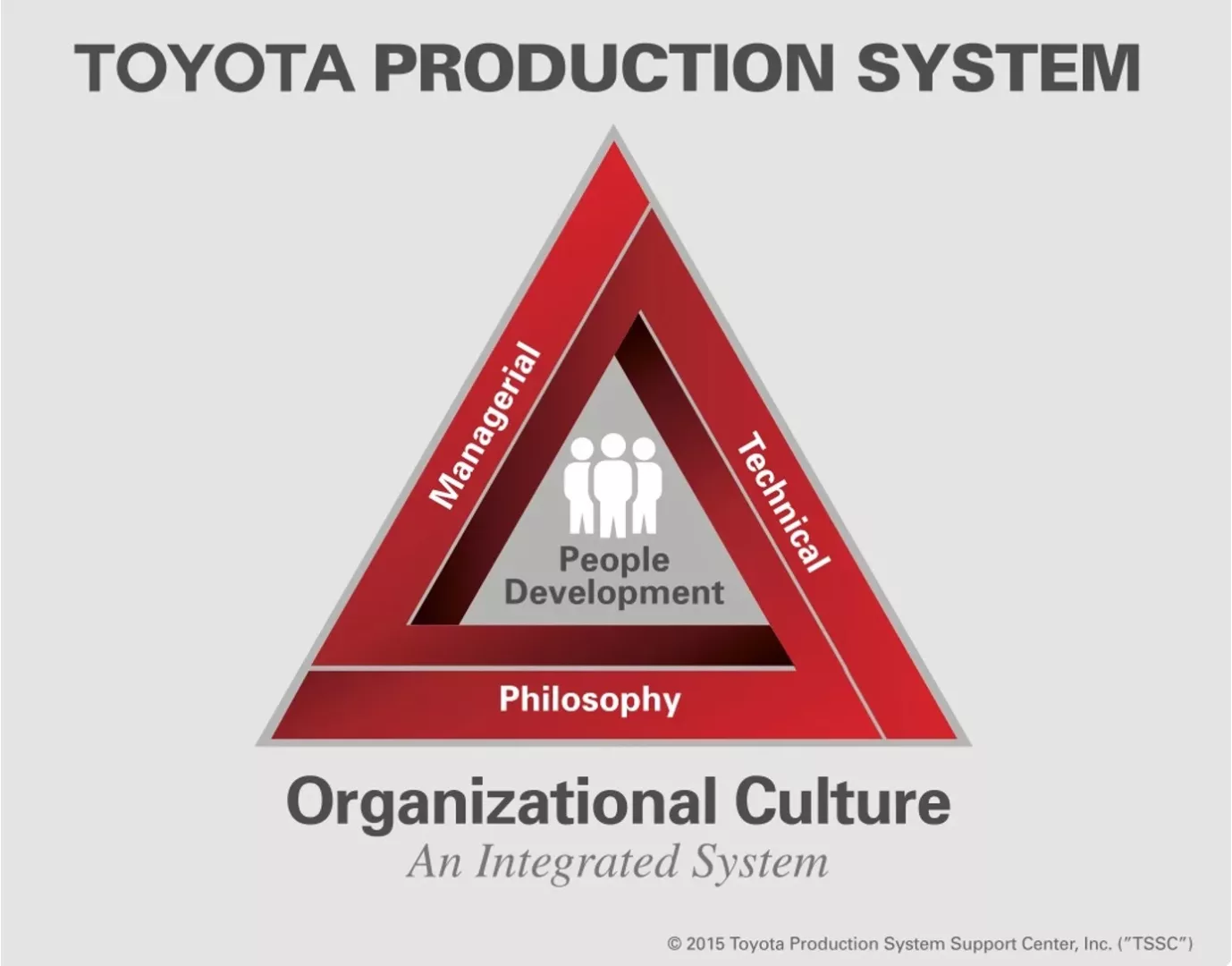Listen to Mark read this post (subscribe to the podcast):
Toyota Philosophy
I made a few tweaks to the content of the third edition of my book Lean Hospitals based on some input from Jamie Bonini, vice president of the TSSC group within Toyota. They are the ones that did the great work with UCLA Harbor Medical Center and others, as highlighted in “The Toyota Effect” videos and earlier work with the NYC Food Bank.
Jamie talked with me and contributed a number of thoughts and ideas about the Toyota Production System and what we might describe elsewhere as “Lean Culture.”
There's a triangle diagram on the TSSC webpage that describes an “integrated system” that consists of:
- technical methods
- managerial methods
- philosophy
All of this is “focused on people development,” Jamie told me for the book.
The model starts with people and human development in the middle, as “people are the most valuable resource,” says Bonini.

This is a triangle that I first heard mentioned almost exactly 10 years ago by Gary Convis, a former Toyota executive and I had included my own version of the diagram in earlier editions of the book. I had never seen the official Toyota version of it… had just created my own based on the description.
Jamie told me, in one discussion, that the philosophy is the most important thing. That doesn't mean it's the only thing. From what I've seen, Lean tools are an offshoot of the philosophy. A certain philosophy leads to the development of tools or methods like “andon cords” or 5S. The tool without the underlying philosophy is definitely missing something.
What is that philosophy? Jamie says it has four parts:
- Customer first; provide customers with what they want, when they want it, and in the amount they want it
- People are the most valuable resource; Deeply respect, engage, and develop people
- Continuous improvement (kaizen); Engage everyone each and every day
- Shop floor (gemba) focus: Go to where the work is done to find and solve problems
If any of that philosophy is missing, I'd say that's where so-called “Lean” efforts starting seeming more like L.A.M.E. than Lean.
When I've complained about cost-cutters who masquerade as Lean thinkers, Jamie told me:
“There are cases where people are pushing Lean, just focusing on tools and the results those tools can get. It can be powerful… they can great results, but it's a double edged sword. But they're not using them with the right managerial approach and philosophy.
They're getting exposed to just one third of an integrated system.”
The philosophy, the mindsets, and the ways of thinking… those are the most important elements of Lean or TPS. They're also the hardest to really understand and the most difficult to copy.
How does your organization line up against those four points of Toyota's philosophy? Do you have your own philosophy that is still compatible with Lean methods? Can an existing organization hope to actually adopt a new philosophy? That's far more difficult than copying a few Lean tools.
I'm hoping to have Jamie as a guest on the podcast soon, where we can discuss this in more detail. What questions would you have for him? Please leave a comment on this post.
What do you think? Please scroll down (or click) to post a comment. Or please share the post with your thoughts on LinkedIn – and follow me or connect with me there.
Did you like this post? Make sure you don't miss a post or podcast — Subscribe to get notified about posts via email daily or weekly.
Check out my latest book, The Mistakes That Make Us: Cultivating a Culture of Learning and Innovation:









Thanks for sharing, Mark. I love the triangle and the 4 steps. I’m often asked the question, “How do I build a Lean culture?”, and it’s a tough one to answer. This information can provide a guideline from which to assess progress toward the goal.
By the way, good luck with the new edition of the book.
Thanks, Dean. I agree this is a helpful framework. I wouldn’t call it “4 steps” as in being sequential, but 4 points that are interconnected and required.
Thanks also for your help in introducing me to the publisher originally! :-)
No problem. The book has been a great success – well done. I recommend it whenever I speak to a healthcare audience.
As Dr. Deming said…. we have to “adopt the new philosophy.”
Easier said than done.
See Michel Baudin’s post on the “new philosophy.”
Lean and Deming was always easier for me to embrace because this is what I learned at the START of my career.
Trying to embrace this after 20 or 30 years as a leader… I can’t imagine how difficult this is.
Hi Mark,
Without question, the TPS – both past and present – represents a very challenging entity to define and characterize; especially in ways that accurately and comprehensively convey the essence of what it really is. In this regard, my reading of this article and my listening to Jamie Bonini (VP of TSSC Group) leave me with little more than an obfuscated impression of what they are attempting to convey.
Note: I’ll be the first to admit that the English language presents major challenges to any user in terms of capturing and conveying precise and readily comprehensible interpretations/translations of ideas/concepts/notions; particularly those that evolved in unique ways and in unique environments.
By way of providing examples of what I’m referring to, the following instances represent major “disconnects” that are being “built-into” the definition/interpretation of the TPS/Toyota Way:
1) In the video that appears on the TSSC website, JB states that “the Toyota Production SYSTEM is a “CULTURE.” Well, if that’s really the case, then why not simply call it the Toyota Production CULTURE or just the Toyota CULTURE?
2) Then, he and the triangle diagram go on to portray the TPS as an organizational “CULTURE;” one that consists of three key elements: “PHILOSPHY” (i.e. improvement-oriented, hands-on learning-by-doing), “TECHNICAL TOOLS” being portrayed as architectural “PILLARS” supporting the notions of Quality, Cost and Lead-time (i.e., JIT-related and Jidoka/Autonomation-related, both of which are resting on a base of “STABILITY”).
3) As JB goes on to describe/explain the objective underlying the use of the JIT-related TOOLS as working for [toward] a state [of being][such that] when a customer makes an order, we can deliver their product one-by-one, immediately… the essence of a high level of “FLOW.” … “That tells you that this BUILT-IN QUALITY ASPECT (????)is WORKING AT A HIGH LEVEL (?????).”
4) And then JB goes on to explain the third “piece” of this “SYSTEM” (I thought we were referring to TPS as a “CULTURE”) as a MANAGERIAL “ROLE” (i.e., developing people to surface problems and solve problems to make improvements). He concludes (and rightly so) that it’s only when the three are working together that one can have very “powerful SYSTEM” that can deliver “sustained results”… WHAT RESULTS?
Note: I don’t know about you, but to me this description of the TPS/Toyota Way – as presented by JB – turned into a major hairball of interwoven, entangled ideas/notions/concepts. It’s being presented in a manner that I like to refer to as the RAGU SPAGHETTI SAUCE approach; that is, “IT’S [ALL} IN THERE.” In fact, as a result, what’s being totally lost in the explanation is the fact that the TPS/Toyota Way is actually a SYSTEM that represents a highly-structured/integrated/systematic and systemic/holistic approach to pursuing and sustaining superior levels of operational excellence; one that is continually evolving/emerging/adapting in response to the changing conditions in the overall business milieu in which the SYSTEM exists. It makes no mention whatsoever of the need to for all members of the enterprise to engage in SYSTEMS-THINKING as a foundation for pursuing improvement. Accordingly, it’s no wonder that there is so much confusion around the notion of “lean” and how it relates back to the TPS/Toyota Way. Depending on who attempts to do the untangling and explaining, there is a greatly increased likelihood that what results will be a plethora of conceptual explanations, all of which are different and subject to being made actionable via different approaches. YIKES!!!!
I guess it goes to show that Toyota still has room for improvement in how they explain this.
Part of the challenge is that we’re asking them to be a fish who describes the water that surrounds them.
It’s like a person being asked to explain, “What does air feel like?” or “Explain to me how to breathe?”
One thing Bonini is trying to get across is that TPS/Lean is an “integrated system.”
Fujio Cho has tried to explain the same (as recounted here:
Too many organizations try to pick and choose the parts of Lean that sound good to them, ignoring other parts of the integrated system…
Hi Mark,
I have a question. How difficult it is to implement a new philosophy or new Lean Technique in the Organizations?
It’s much easier to adopt a few Lean tools than it is to adopt a new philosophy. Culture change is hard.
IS adoption of Lean tools a time taking process?
Thanks
[…] quality management practices run deep at many Japanese hospitals, it does not appear that a full Lean management system is yet being practiced in hospitals in […]
[…] We covered basic Lean methods and principles, emphasizing that Lean is not just tools, it’s a philosophy and a management system. […]
[…] (the Japanese word jidoka), through detecting and preventing errors, is one of the pillars of the Toyota Production System.[xiv] The history of jidoka dates to the time before the company even built cars. Sakichi Toyoda […]